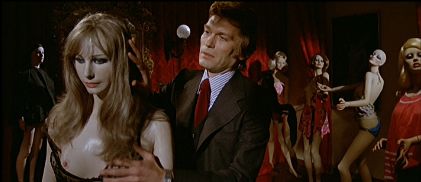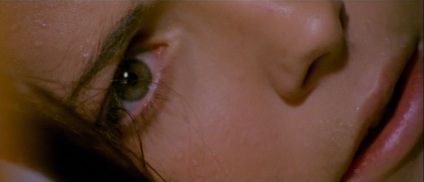« Some thoughts on The Online Film Community's Top 100 Movies | Main | A Scandal in Paris »
August 03, 2007
La Dolce Morte

Spasmo (Umberto Lenzi - 1974)
La Dolce Morte: Vernacular Cinema and the Italian Giallo Film
Mikel J. Koven
The Scarecrow Press, Inc. - 2006
As a writer, Mikel J. Koven reminds me of the divided characters he describes in La Dolce Morte. While stating that he wants to discuss giallo films on its own terms, Koven loves to pepper his sentences with words like diegetic and liminal among the favorites. The book is described as "the first academic study of the giallo film in English". In this case, academic means boring.

What Have You Done to Solange? (Massimo Dallamano - 1972)
There seemed also to be an assumption on Koven's part that whomever would read his book would not be familiar with any of the other books about giallo. How else to explain his mentioning of Maitland McDonagh's study of Dario Argento, Broken Mirrors/Broken Minds only in reference to Argento, but not to note that she wrote about the literary roots of giallo films twelve years earlier? While Koven greatly amplifies the history of the yellow mystery paperbacks, as well as the influence Agatha Christie has had both in print and on film, he was not the first to make those connections. Koven may have missed the point when he mentions how film critic Kim Newman compared Dario Argento with Vincente Minnelli, only mentioning how the two filmmakers choose to suspend filmic reality for their highly stylized set pieces, with Minnelli usually in the form of his major dance numbers, while with Argento, in his more elaborate scenes of mayhem. Not having read Newman's original piece, I may be taking what was written out of context as well, but I think Newman was not as "flippant" as Koven assumes. What Minnelli and Argento also have in common is their dramatic use of color as well as their moments of briefly shifting within a scene from something to be viewed as reality to a change of exterior setting to reflect an interior shift within that character. A very rough comparison might be in the scene in Some Came Running where Frank Sinatra is in a mansion, questioning his life with Martha Hyer. The interior is a large room, when suddenly Minnelli briefly changes the lighting to something more stagey, to visually illustrate Sinatra's sense of isolation from his environment. Roughly analogous to that would be the scenes in Argento's The Stendhal Syndrome where Asia Argento becomes literally lost in the painting she is viewing at the museum, a painting which comes alive and is transformed temporarily into her environment. Also undercutting Koven's pretensions is the faulty proofreading that renders Pupi Avati's last name as Avanti on one page. (Reading Avanti made me think of Billy Wilder's film of that title, and the comic possibilities we will never know with a character named Pupi.) To prove that the proofreader should ring twice, Koven also refers to author James M. Caine.
What is of interest in La Dolce Morte is Koven's theory of vernacular cinema. Koven discusses how many of the gialli were made to be shown in what were called terza visione (literally third vision) theaters. Playing to a primarily working class audience before television finally decimated the filmgoing habit, going to the neighborhood theater to get out of the house and socialize was more to the point than actually paying close attention to what was happening on the screen. Koven argues that what has been criticized as weak narratives is besides the point, and that the audience cares more about the set pieces, in this case the various acts of murder that take place on screen. There are some interesting ideas that lead to the concept of popular and populist entertainment which in turn made me think of the changes in Hollywood filmmaking which maybe have been incorrectly articulated both by critics and by those speaking on behalf of the studios. By this I mean that with the emphasis on marketing and opening weekend box office combined with a youthful audience that is more interested in the social act of going to the movies, that mainstream Hollywood film is a form of vernacular cinema. In this regard, well written screenplays and thought out visual motifs are besides the point. Much like the films made for terza visione theaters, many current mainstream Hollywood films simply may not be made for critical scrutiny. This explains why comedies that never rise above the level of mediocre television sit-coms have been popular. This may also explain why Michael Bay makes films in his particular style, which is his way of forcing audience attention. It is in his chapter on vernacular cinema that Koven is most interesting, and even exciting, to read.
It is when Koven writes about gialli films that he tends to get dull. While Koven complains about other writers, his own use of language which is hardly vernacular makes me wonder who he is trying to address. If there are any academic film scholars who are still too squeamish to bother with Dario Argento or Mario Bava, much less Sergio Martino or Lucio Fulci, I'm not sure if La Dolce Morte will necessarily inspire them to check out The Beyond or Spasmo. Those who might appreciate a good overview of the giallo film might be frustrated by a book that screams at the reader to check the dictionary every few pages, that they might simply jump to the filmography in the back. I have little patience for books about film that have no stills or frame reproductions. What does no one any favors is that La Dolce Morte is one very high priced book about a form of film that emphasizes the visual, that needs to be seen to be understood, and yet with the exception of the cover, a still from Blood and Black Lace, there are no bloody illustrations.

The Pyjama Girl Case (Flavio Mogherini - 1977)
Posted by Peter Nellhaus at August 3, 2007 09:00 AM
